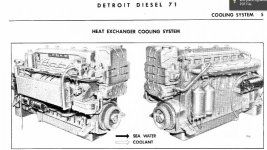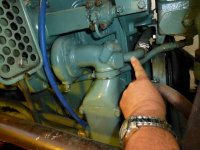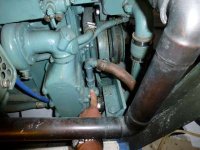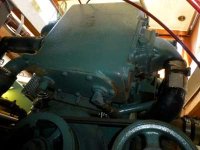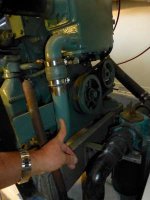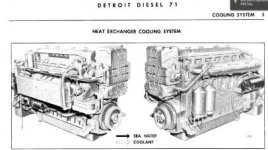Hello MarineEngine.com forum:
I have 2 detroit 6-71's in a 42 ft Uniflite.
Both of which were "marinized" with Johnson Towers coolant systems.
However, the starboard engine had a couple of large hoses coming from an old Triton watermaker which has now been removed from the boat and I want to reconfigure the coolant piping to accommodate the loss of the old watermaker.
I'm not sure why the watermaker was connected to the Starboard engine only, but I suspect that the Starboard engine was meant to be run to help pump seawater to the primary portion (low pressure side) of the watermaker when underway. [The Starboard engine also has a large 160 amp alternator that was exclusively connected to an old square wave inverter (no longer on the boat) which I suspect helped supply AC power to run the high pressure side of the watermaker when underway.]
Anyway, I want to make sure I don't screw up when I reconfigure the coolant hoses on the starboard engine. So, I need to ask about my plans to connect a hose from the exhaust manifold on the starboard engine to what I think is the oil cooler.
By the way, this is exactly the same configuration as is found on the Port engine, so my confidence level is aided by what I see on the Port side engine, but I would like to elicit comments, and votes of confidence from some of the more knowledgeable folks on this forum.
I've attached a few photos to illustrate what I'm thinking about doing, without knowing exactly why I'm doing it.
Any advice, other information,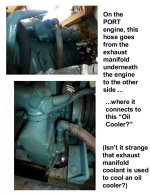
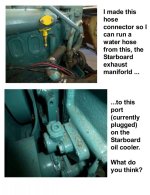

 and/or votes of confidence are truly appreciated.
and/or votes of confidence are truly appreciated.
Jim
I have 2 detroit 6-71's in a 42 ft Uniflite.
Both of which were "marinized" with Johnson Towers coolant systems.
However, the starboard engine had a couple of large hoses coming from an old Triton watermaker which has now been removed from the boat and I want to reconfigure the coolant piping to accommodate the loss of the old watermaker.
I'm not sure why the watermaker was connected to the Starboard engine only, but I suspect that the Starboard engine was meant to be run to help pump seawater to the primary portion (low pressure side) of the watermaker when underway. [The Starboard engine also has a large 160 amp alternator that was exclusively connected to an old square wave inverter (no longer on the boat) which I suspect helped supply AC power to run the high pressure side of the watermaker when underway.]
Anyway, I want to make sure I don't screw up when I reconfigure the coolant hoses on the starboard engine. So, I need to ask about my plans to connect a hose from the exhaust manifold on the starboard engine to what I think is the oil cooler.
By the way, this is exactly the same configuration as is found on the Port engine, so my confidence level is aided by what I see on the Port side engine, but I would like to elicit comments, and votes of confidence from some of the more knowledgeable folks on this forum.
I've attached a few photos to illustrate what I'm thinking about doing, without knowing exactly why I'm doing it.
Any advice, other information,



 and/or votes of confidence are truly appreciated.
and/or votes of confidence are truly appreciated.Jim


